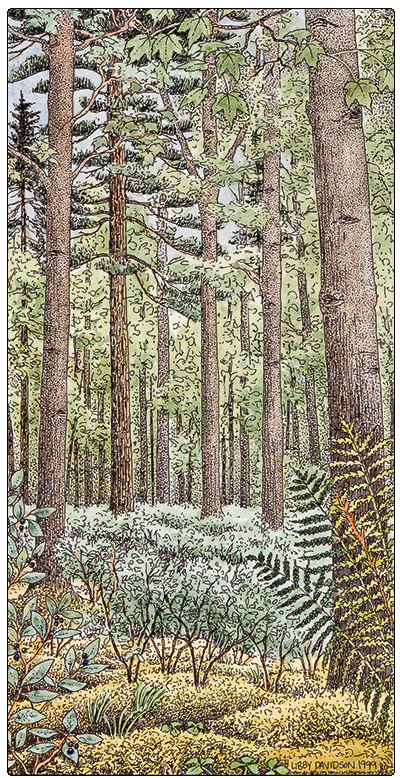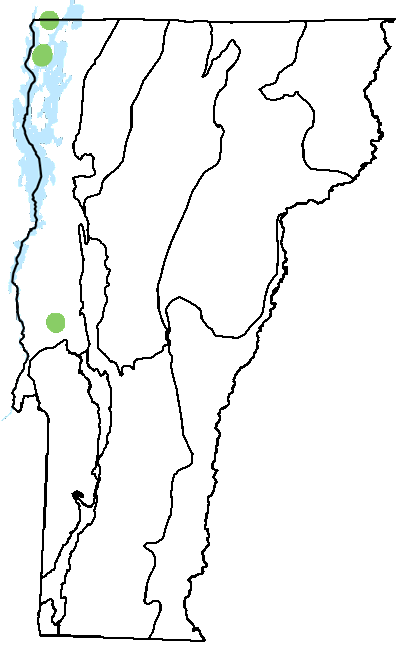Ecology and Physical Setting 
Red Maple-White Pine-Huckleberry Swamps are rare in Vermont. They occur in the center of much larger wetland complexes. The soils in these swamps are deep peats—exceeding 11 feet in South Alburgh Swamp—commonly containing wood fragments. It is likely that the Red Maple-White Pine-Huckleberry Swamp communities occur on the deepest organic soils in their respective basins, resulting in a slightly raised condition relative to adjacent wetland communities.
An interesting feature of this swamp type is its relatively flat surface. Although there may be low hummocks, they seldom exceed ten inches in height. The organic soils are permanently saturated, but there are no pools with standing water, and there is no evidence of seasonal flooding. The water near the surface of these wetlands is very acidic, with a pH of 3.5 at South Alburgh Swamp.
Black huckleberry is a fire-tolerant species that persists for long periods after a burn. When we see it forming a dense understory, we think about the possibility of past fires. The raised dome of the wetland, which lacks wet hollows, may cause the top layer of peat to dry out in summer and be susceptible to fire. Tall white pines could attract lightning strikes. So far, ecologists have not found charcoal in the soil, or other evidence of fire, but additional study would help us understand the role of fire in Red Maple-White Pine-Huckleberry Swamps.
Vegetation
Red Maple-White Pine-Huckleberry Swamps have a distinct forest structure. Red maple dominates the canopy, which varies from 70 to 90 percent closure. White pine, black spruce, and tamarack are all important components but are much less abundant than red maple. Tall, scattered white pines rise above the red maples. Tall shrubs are notably sparse, with a scattering of highbush blueberry, mountain holly, and red maple saplings. Black huckleberry forms dense thickets, with lesser amounts of Labrador tea, low sweet blueberry, and regeneration of the overstory tree species.
Herbaceous plant cover is sparse; cinnamon fern is most abundant. Boreal herbs, including goldthread, bluebead lily, Canada mayflower, and starflower, are common. Sarsaparilla and pink lady’s slipper are also present. Three-seeded sedge has a patchy distribution in these swamps. Bryophyte cover is very high and is strongly dominated by several sphagnum species, especially Sphagnum centrale, with lesser amounts of Sphagnum capillifolium.
Wildlife Habitat
The dense carpet of saturated sphagnum moss makes these swamps ideal habitat for the rare four-toed salamander. The rare blue-spotted salamander is found in several types of swamps at low elevation, and often co-occurs with four-toed salamanders. The tall, emergent white pines, dominant in some swamps, provide nesting habitat for pine warblers. Pine warblers are one of the first warbler species to arrive in Vermont, and their musical trill enlivens the canopy of these and other pine forests in mid-April. Other breeding birds include veery, brown creeper, and great crested flycatcher. The brown elfin has not been found in this natural community, but since it relies on heath shrubs, including black huckleberry, as host plants, it may turn up.
Related Communities
- Red Maple-Black Ash Seepage Swamp is more enriched and has higher species diversity, with many species indicative of groundwater discharge. Black ash is a characteristic co-dominant canopy tree. Huckleberry, black spruce, and other acidic soil indicators are absent.
- Red Maple-Sphagnum Basin Swamp is similar in having red maple and sphagnum, but is typically found in smaller basins. Huckleberry is not dominant. These swamps have more pronounced hummocks and hollows.
Conservation Status and Management Considerations
This is a rare natural community in Vermont. All examples should be protected, along with the larger wetland complexes in which they occur. Additional inventory is needed to identify other examples in Vermont and the region.
Distribution/Abundance 
Very few examples of Red Maple-White Pine-Huckleberry Swamps are known from Vermont. All are in the Champlain Valley. No other states in the region appear to have examples of this community.
Characteristic Plants
Trees
Abundant Species
Red maple – Acer rubrum
Occasional to Locally Abundant Species
White pine – Pinus strobus
Black spruce – Picea mariana
Tamarack – Larix laricina
Gray birch – Betula populifolia
Yellow birch – Betula alleghaniensis
Shrubs
Abundant Species
Black huckleberry – Gaylussacia baccata
Occasional to Locally Abundant Species
Highbush blueberry – Vaccinium corymbosum
Labrador tea – Rhododendron groenlandicum
Mountain holly – Ilex mucronata
Low sweet blueberry – Vaccinium angustifolium
Herbs
Abundant Species
Cinnamon fern – Osmundastrum cinnamomeum
Occasional to Locally Abundant Species
Goldthread – Coptis trifolia
Bluebead lily – Clintonia borealis
Canada mayflower – Maianthemum canadensis
Starflower – Lysimachia borealis
Three-seeded sedge – Carex trisperma
Sarsaparilla – Aralia nudicaulis
Pink lady’s slipper – Cypripedium acaule
Bryophytes
Abundant Species
Moss – Sphagnum centrale
Occasional to Locally Abundant Species
Moss – Sphagnum capillifolium
Moss – Sphagnum angustifolium
Moss – Sphagnum magellanicum
Moss – Sphagnum fimbriatum
Bog haircap moss – Polytrichum strictum
Moss – Aulacomnium palustre
Three-lobed bazzania – Bazzania trilobata
Rare and Uncommon Plants
Yellow bartonia – Bartonia virginica
Associated Animals
Veery – Catharus fuscescens
Great crested flycatcher – Myiarchus crinitus
Pine warbler – Dendroica pinus
Brown creeper – Certhia americana
Rare and Uncommon Animals
Four-toed salamander – Hemidactylium scutatum
Blue-spotted salamander – Ambystoma laterale
Brown elfin – Callophrys augustinus
Places to Visit
South Alburgh Swamp, Alburgh Dunes State Park, Vermont Department of Forests, Parks, and Recreation
Cornwall Swamp, Cornwall, Vermont Fish and Wildlife Department and The Nature Conservancy
